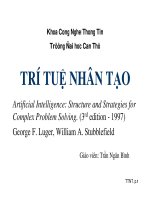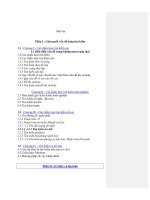Slide trí tuệ nhân tạo chapter7 1 using logic
Bạn đang xem bản rút gọn của tài liệu. Xem và tải ngay bản đầy đủ của tài liệu tại đây (238.39 KB, 63 trang )
Using Logic
Chapter 7
CuuDuongThanCong.com
/>
Using Propositional Logic
Representing simple facts
It is raining
RAINING
It is sunny
SUNNY
It is windy
WINDY
If it is raining, then it is not sunny
RAINING SUNNY
Cao Hoang Tru
CSE Faculty - HCMUT
CuuDuongThanCong.com
2
4 April, 2012
/>
Propositional Logic Syntax
• Logical constants: true, false
• Propositional symbols: P, Q, …
• Logical connectives: , , , ,
• Sentences (formulas):
–
–
–
–
Logical constants
Proposition symbols
If is a sentence, then so are and ()
If and are sentences, then so are , , ,
and
Cao Hoang Tru
CSE Faculty - HCMUT
CuuDuongThanCong.com
3
4 April, 2012
/>
Propositional Logic Semantics
• Interpretation: propositional symbol true/false
• The truth value of a sentence is defined by the truth
table
P
Q
P
PQ
PQ
PQ
PQ
false
false
true
false
false
true
true
false
true
true
false
true
true
false
true
false
false
false
true
false
false
true
true
false
true
true
true
true
Cao Hoang Tru
CSE Faculty - HCMUT
CuuDuongThanCong.com
4
4 April, 2012
/>
Propositional Logic Semantics
• Satisfiable: true under an interpretation
• Valid: true under all interpretations
P
Q
P P
(P Q) Q
((P Q) Q) P
false
false
false
false
true
false
true
false
false
true
true
false
false
true
true
true
true
false
false
true
satisfiable
valid
unsatisfiable
Cao Hoang Tru
CSE Faculty - HCMUT
CuuDuongThanCong.com
5
4 April, 2012
/>
Propositional Logic Semantics
• Model: an interpretation under which the sentence is
true
PQ
PQ
PQ
P
PQ
P
CuuDuongThanCong.com
Q
PQ
Cao Hoang Tru
CSE Faculty - HCMUT
Q
PQ
6
4 April, 2012
/>
Propositional Logic Semantics
• Entailment: KB = iff every model of KB is a model of
is a logical consequence of KB
P
Q
PQ
P Q, P
false
false
true
false
false
true
true
false
true
false
false
false
true
true
true
true
Cao Hoang Tru
CSE Faculty - HCMUT
CuuDuongThanCong.com
{P Q, P} = Q
7
4 April, 2012
/>
Propositional Logic Semantics
• Equivalence: iff = and =
P
Q
PQ
P Q
false
false
true
true
false
true
true
true
true
false
false
false
true
true
true
true
Cao Hoang Tru
CSE Faculty - HCMUT
CuuDuongThanCong.com
P Q P Q
8
4 April, 2012
/>
Propositional Logic Semantics
• Theorems:
– = iff is valid
KB = can be proved by validity of KB
– = iff is unsatisfiable
KB = can be proved by refutation of KB
Cao Hoang Tru
CSE Faculty - HCMUT
CuuDuongThanCong.com
9
4 April, 2012
/>
Using Propositional Logic
• Theorem proving is decidable
• Cannot represent objects and quantification
Cao Hoang Tru
CSE Faculty - HCMUT
CuuDuongThanCong.com
10
4 April, 2012
/>
Predicate Logic Syntax
• Constant symbols: a, b, c, John, …
to represent primitive objects
• Variable symbols: x, y, z, …
to represent unknown objects
• Predicate symbols: safe, married, love, …
to represent relations
married(John)
love(John, Mary)
Cao Hoang Tru
CSE Faculty - HCMUT
CuuDuongThanCong.com
11
4 April, 2012
/>
Predicate Logic Syntax
• Function symbols: square, father, …
to represent simple objects
safe(square(1, 2))
love(father(John), mother(John))
• Terms:
to represent complex objects
– Constant symbols
– If f is a function symbol, and t1, t2, …, tn are terms,
then so is f(t1, t2, …, tn)
love(mother(father(John)), John)
Cao Hoang Tru
CSE Faculty - HCMUT
CuuDuongThanCong.com
12
4 April, 2012
/>
Predicate Logic Syntax
• Logical connectives: , , , ,
• Universal quantifier: "x: p(x)
"x: love(father(x), mother(x))
• Existential quantifier: $x: p(x) "x: p(x)
$x: married(x)
Cao Hoang Tru
CSE Faculty - HCMUT
CuuDuongThanCong.com
13
4 April, 2012
/>
Predicate Logic Syntax
• Sentences:
– Atomic sentences: p(t1, t2, …, tn)
– If is a sentence, then so are and ()
– If and are sentences, then so are , , ,
and
– If is a sentence, then so are " and $
Cao Hoang Tru
CSE Faculty - HCMUT
CuuDuongThanCong.com
14
4 April, 2012
/>
Using Predicate Logic
• Can represent objects and quantification
• Theorem proving is semi-decidable
Cao Hoang Tru
CSE Faculty - HCMUT
CuuDuongThanCong.com
15
4 April, 2012
/>
Using Predicate Logic
1.
Marcus was a man.
2.
Marcus was a Pompeian.
3.
All Pompeians were Romans.
4.
Caesar was a ruler.
5.
All Pompeians were either loyal to Caesar or hated him.
6.
Every one is loyal to someone.
7.
People only try to assassinate rulers they are not loyal to.
8.
Marcus tried to assassinate Caesar.
Cao Hoang Tru
CSE Faculty - HCMUT
CuuDuongThanCong.com
16
4 April, 2012
/>
Using Predicate Logic
1.
Marcus was a man.
man(Marcus)
Cao Hoang Tru
CSE Faculty - HCMUT
CuuDuongThanCong.com
17
4 April, 2012
/>
Using Predicate Logic
2.
Marcus was a Pompeian.
Pompeian(Marcus)
Cao Hoang Tru
CSE Faculty - HCMUT
CuuDuongThanCong.com
18
4 April, 2012
/>
Using Predicate Logic
3.
All Pompeians were Romans.
"x: Pompeian(x) Roman(x)
Cao Hoang Tru
CSE Faculty - HCMUT
CuuDuongThanCong.com
19
4 April, 2012
/>
Using Predicate Logic
4.
Caesar was a ruler.
ruler(Caesar)
Cao Hoang Tru
CSE Faculty - HCMUT
CuuDuongThanCong.com
20
4 April, 2012
/>
Using Predicate Logic
5.
All Pompeians were either loyal to Caesar or hated him.
inclusive-or
"x: Roman(x) loyalto(x, Caesar) hate(x, Caesar)
exclusive-or
"x: Roman(x) (loyalto(x, Caesar) hate(x, Caesar))
(loyalto(x, Caesar) hate(x, Caesar))
Cao Hoang Tru
CSE Faculty - HCMUT
CuuDuongThanCong.com
21
4 April, 2012
/>
Using Predicate Logic
6.
Every one is loyal to someone.
"x: $y: loyalto(x, y)
Cao Hoang Tru
CSE Faculty - HCMUT
CuuDuongThanCong.com
$y: "x: loyalto(x, y)
22
4 April, 2012
/>
Using Predicate Logic
7.
People only try to assassinate rulers they are not loyal to.
"x: "y: person(x) ruler(y) tryassassinate(x, y)
loyalto(x, y)
Cao Hoang Tru
CSE Faculty - HCMUT
CuuDuongThanCong.com
23
4 April, 2012
/>
Using Predicate Logic
7.
People only try to assassinate rulers they are not loyal to.
"x: "y: person(x) ruler(y) tryassassinate(x, y)
loyalto(x, y)
Cao Hoang Tru
CSE Faculty - HCMUT
CuuDuongThanCong.com
24
4 April, 2012
/>
Using Predicate Logic
8.
Marcus tried to assassinate Caesar.
tryassassinate(Marcus, Caesar)
Cao Hoang Tru
CSE Faculty - HCMUT
CuuDuongThanCong.com
25
4 April, 2012
/>









